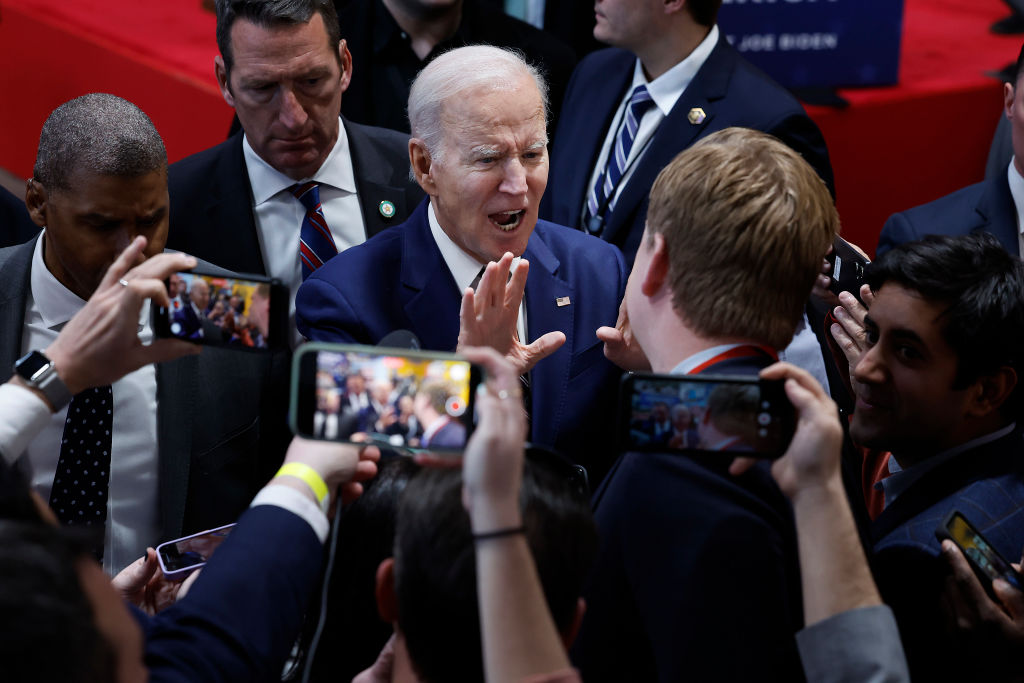Another year, another deficit-fueled federal budget. Despite claiming to be monetarily responsible, President Joe Biden’s fiscal year 2024 is the stuff of which nightmares are made, filled with exorbitant wealth confiscation policies, astronomical spending, and ballooning deficits. Unfortunately, one glance at the Biden budget confirms that the idea of public officials being conservative with taxpayer dollars has been buried at the National Archives. It is unfortunate to report, but nobody should expect a balanced budget anytime soon. So, what is inside the latest presentation that is unlikely to pass the Republican-controlled House? Grab your calculators.
Biden Budget Basics
The White House released Biden’s third budget of his presidency and the first of a divided Congress. The proposed numbers are staggering: $6.9 trillion in spending, roughly $5 trillion in tax hikes and new levies, $17 trillion in cumulative deficits over the next decade, trillions of dollars in interest payments, and tepid real GDP year-over-year growth (between 1.5% and 2.3%). Once again, the administration championed the Biden budget as one that “rewards work, not wealth” by targeting the wealthiest Americans. However, the current outline ostensibly places a bullseye on everyone’s back directly and indirectly. House Speaker Kevin McCarthy (R-CA) might have best summarized the proposal as “completely unserious.”
Tax and Spend
The Biden budget contains a treasure trove of tax hikes and fresh penalties to generate revenues.
The main proposal includes a 25% minimum tax on Americans with more than $100 million that will go after all appreciated assets (once again, this will consist of unrealized gains on individuals). The president additionally plans to raise the corporate tax rate to 28%, up from 21%. The FY 2024 plan repeals several components of former President Donald Trump’s Tax Cuts and Jobs Act (TCJA), including “taxing capital gains at the same rate as wage income for those with more than $1 million income.” He also wants to quadruple the stock buyback tax from 1% to 4%, raise the top individual tax rate to 39.6%, bolster the net investment income tax (NIIT) by 1.2%, and increase the Medicare taxes to 5% for people earning more than $400,000.
Here is a brief list of other notable tax proposals:
- Imposing a carried interest tax on capital gains.
- Limiting retirement plan benefits for individuals with account balances above $10 million and earnings above $400,000.
- Taxing corporate distributions as dividends.
- Changing the tax treatment of cryptocurrency transactions.
- Raise the capital gains from real estate transactions by abolishing Like-Kind Exchanges.
- Installing a phased-in 30% digital asset mining energy excise tax.
Shalanda Young, director of the Office of Management and Budget (OMB), asserts that revenues generated from these taxes will go toward the president’s spending priorities and the wide range of progressive goodies. Here is a brief list of what the administration wants to spend in the next fiscal year:
- Expand access and funding for pre-K and child care: $600 billion.
- Expand the Child Tax Credit through 2025: $435 billion.
- Grow and extend Affordable Care Act (ACA) coverage and subsidies: $383 billion.
- Establish national paid family and medical leave: $325 billion.
- Offer free community college and increase higher education spending: $217 billion.
- Support affordable housing: $105 billion.
- Ukraine assistance: $6 billion.
- Help impoverished countries tackle global warming: $3 billion.
“Families need a little breathing room, and that’s why the budget includes proposals to bring down the cost of everyday necessities and lowers healthcare costs,” she said, adding that asking the affluent to begin paying their “fair share” will ensure these programs are fully covered.
Drowning in Red Ink
 President Biden and administration officials touted that this budget proposal reduces the deficit by $3 trillion over ten years. The numbers suggest that this is an accurate characterization of the plan, although any future budget negotiations will need to consider this budget. That said, here is the kicker: the budget shortfalls are still pronounced in 2024 and beyond. Next year, the Oval Office anticipates running a deficit of $1.846 trillion. By 2033, the White House forecasts more than $17 trillion of cumulative deficits (primary deficit plus net interest payments), representing roughly 5% of GDP. Indeed, annual debt-servicing costs are expected to top $1 trillion in six years, totaling about $10.2 trillion
President Biden and administration officials touted that this budget proposal reduces the deficit by $3 trillion over ten years. The numbers suggest that this is an accurate characterization of the plan, although any future budget negotiations will need to consider this budget. That said, here is the kicker: the budget shortfalls are still pronounced in 2024 and beyond. Next year, the Oval Office anticipates running a deficit of $1.846 trillion. By 2033, the White House forecasts more than $17 trillion of cumulative deficits (primary deficit plus net interest payments), representing roughly 5% of GDP. Indeed, annual debt-servicing costs are expected to top $1 trillion in six years, totaling about $10.2 trillion
As a result of this enormous deficit-financed spending, the federal debt held by the public would soar to above $43 trillion in the next decade, increasing the debt-to-GDP ratio to 110%. It should be noted that this is different from the national debt, which is held by the Federal Reserve and foreign governments.
However, this assumes the government’s rate projections are accurate. For example, the OMB proposal estimates that ten-year Treasury notes will be 3.4% to 3.5% over the next decade.
On the broader economy, the Biden budget also projects that inflation will normalize sooner than the Federal Reserve and Congressional Budget Office (CBO) forecast: sliding from 3% in this year’s fourth quarter to 2.3% in the October-December period next year. The GDP forecasts suggest a return to the Obama economy, as the White House forecasts 0.3% real GDP growth in 2023, 2.1% in 2024, and 2.2% annual growth by the decade’s end. These are still rosier than what the Fed and CBO expect on this horizon.
While the Committee for a Responsible Federal Budget (CRFB) applauded the administration for the $3 trillion in savings, it was not pleased by the “excessive” spending in this budget.
“At $6.9 trillion, spending next year would be higher than any time during the pandemic and about $2.5 trillion above the pre-pandemic level, representing growth of 55 percent,” said Maya MacGuineas, president of the CRFB, in a statement. “Despite the nearly $600 billion of prescription drug, defense, and other savings, the budget would spend about 25 percent of the economy per year – unheard of outside of a national emergency. There is nothing wrong with having a spending wish list, but we should wait to implement major new spending or tax cuts until the nation’s fiscal situation is stabilized – a plan that still requires $19 trillion of borrowing is nowhere near under control.”
What About Social Security?
For weeks, the Democrats have lambasted Republicans for apparently wanting to cut or abolish Social Security. However, the Biden budget does not address any plan to ensure the retirement scheme’s solvency, although it promises to remain intact for the next 25 years. Remember, the Social Security trust fund will be insolvent by 2035.
“This Budget protects and strengthens Social Security and Medicare—lifelines that tens of millions of seniors have paid into their whole lives with every paycheck so they can retire with dignity,” the budget report stated. “It rejects any cuts to these programs, extends the solvency of the Medicare Trust Fund by at least 25 years, and invests in service delivery so that seniors and people with disabilities can access the benefits they have earned.”

(Photo by Chip Somodevilla/Getty Images)
The administration does vow to give the Social Security Administration (SSA) a 10% increase, representing an additional $1.4 billion, to increase manpower, invest in information technology, and make other improvements. But nothing within the budget lays out efforts to prevent an automatic 20% reduction in benefits in 12 years.
Tax the Rich
Many Americans would scoff at the notion of taxing the rich. But, since a number of these tax hikes would focus on the wealthiest Americans, why would someone earning $30,000 a year and struggling to pay their bills in Biloxi, MS, care? The issue is that steep business taxes are almost always passed on to customers, whether in the form of higher prices or smaller retirement investments. Plus, if the US is slipping into a recession, it could also be challenging for corporations to respond to an economic downturn.
Some of the tax concepts impact small businesses. Indeed, raising the top individual tax rate to 39.6% would hit Main Street, especially small business sole proprietorships, S-corporations, partnerships, and LLCs. The corporate tax jump would impact small employers identified as C-corporations. The 31% spike in Medicare taxes does not have an income cap and essentially produces a new top tax bracket.
Meanwhile, the White House keeps uttering the term “fair share.” But how does the administration define “fair share”? The top 1% earned 22% of all income and paid 42% of all income taxes. The top 2% to 5% garnered 16% of all income earned and paid 20% of all income taxes. So, what the White House really means is not “fair share,” but rather, “Give us more.” It is comparable to what economist Thomas Sowell famously wrote: “I have never understood why it is greed to want to keep the money you have earned but not greed to want to take somebody else’s money.”
A Republican Roadblock
It is unlikely that the Biden budget will pass as it is written, primarily because of the GOP-controlled House. How much would the next revised version cost? It all depends on how far the Republican Party is willing to go. History suggests they would probably achieve very little, perhaps trimming it to $6 trillion. Whatever the case, Republicans are already describing it as a disaster, with Rep. Elise Stefanik (R-NY) writing in a statement that “our worst fears were confirmed.” Is it the worst budget in US history? Probably not, since it is more of the same pattern of reckless spending, inflationary deficits, immense debts, and growth in the size and scope of the federal government. It is a hallmark of the Swamp.



